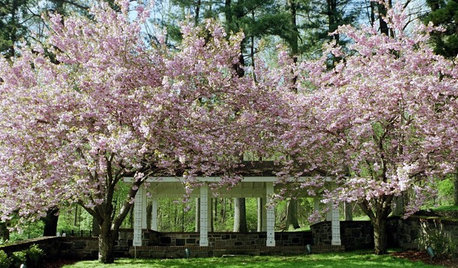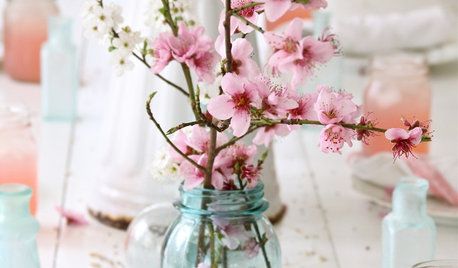other varieties of cherry blossom trees?
Socal2warm
9 years ago
Related Stories

MORE ROOMSCherry Blossoms Spring to 100
This years marks the centennial of the beautiful trees' arrival on our shores. Below, a few ways to celebrate with your landscape and décor
Full Story
EDIBLE GARDENSHow to Grow Your Own Luscious Cherries
Nope, they’re not the easiest fruit to grow. But with spectacular blossoms and pies as possibilities, cherries are sure worth a try
Full Story
DECORATING GUIDESThinking Spring: Blossoming Branches
Cherry, Peach and Apple Flowers Make Interiors Bloom
Full Story
GARDENING GUIDESPlant Black Cherry Trees for the Birds and Bees
Plant Prunus serotina in the Central and Eastern U.S. for spring flowers, interesting bark and beautiful fall color
Full Story
GARDENING GUIDES6 New Plant Varieties That Beat Out Their Parents
With better resistance and fewer demands, these garden beauties are worth a spot on your wish list
Full Story
FRUIT TREESHow to Grow Your Own Juicy Plums
Easier than other stone fruits and with a variety of colors to choose from, plums are a versatile garden addition
Full Story
FLOWERS10 Beautifully Blossoming Spring Centerpieces
Pick a single stem or gather a bouquet. Whatever your style, there's a fresh spring floral arrangement here for you
Full Story
LANDSCAPE DESIGNPretty Trees for Patios, Paths and Other Tight Spots
Choose trees for their size, shape and rate of growth — or shape them to fit your space. Here's how to get started
Full Story
EDIBLE GARDENSWhy Grow Quince? For Beauty, Fragrance and Old-Time Flavor
Delightfully perfumed fruit and lovely spring blossoms make this apple and pear cousin worth a spot in the garden
Full Story
EDIBLE GARDENSHow to Add an Apple Tree to Your Edible Garden
Readily available, beautiful and fragrant, apple trees offer four-season interest along with crisp, juicy fruit
Full Story





ken_adrian Adrian MI cold Z5
Socal2warmOriginal Author
Related Professionals
Parole Landscape Architects & Landscape Designers · Waunakee Landscape Architects & Landscape Designers · Aloha Landscape Contractors · Cornelius Landscape Contractors · North Lauderdale Landscape Contractors · Secaucus Landscape Contractors · Wethersfield Landscape Contractors · Hawaiian Gardens Landscape Contractors · Cheshire Gardeners & Lawn Care · Austin Decks, Patios & Outdoor Enclosures · Athens Decks, Patios & Outdoor Enclosures · Frisco Decks, Patios & Outdoor Enclosures · Layton Decks, Patios & Outdoor Enclosures · Lincolnton Decks, Patios & Outdoor Enclosures · Santa Monica Decks, Patios & Outdoor EnclosuresEmbothrium
Embothrium
Socal2warmOriginal Author
Embothrium
Socal2warmOriginal Author
Embothrium
Socal2warmOriginal Author
Embothrium
Socal2warmOriginal Author
Embothrium
Embothrium
parker25mv
willowmead27